





What has flooding to do with floral fragrance? Read on to discover the link.
(Editor's Note: This article was originally published on August 27, 2008 following the July 9 floods. Your comments are welcome, but please be aware that authors of previously published articles may not be able to respond to your questions.)
The unprecedented horrors caused by the copious amounts of moisture we've had so far this year in the state of Iowa were well-documented by news media throughout the country and abroad. My wife and I were among the lucky ones. While flood waters crept to less than a quarter mile from our house and our basement had a mini creek running through it for awhile, damage was minimal. The cities of Cedar Rapids and Iowa City were not so lucky. Many residences and businesses were swamped with up to ten feet of muddy, polluted, swiftly flowing water.
After several weeks of being inundated with gloomy, nonstop flood news, I began to look for something positive to make of it all.
It turns out that all I had to do was to look around me. The countryside was--and still is--awash in green. Native wildflowers are blooming with unaccustomed gusto. Our flower gardens have never looked better. While such lush growth doesn't justify the flooding nightmare, it is nevertheless a bright spot in an otherwise dark picture.
Another bonus, quite unexpected, has to do not with appearance but with fragrance. I'm speaking here of the kind that drifts on the afternoon or evening breeze as opposed to the kind that requires you to bury your nose in the petals.
I had already noticed earlier this spring that flowers during this very moist growing season are much more fragrant than usual. Lilacs and flowering crabapple trees perfumed the air as never before. The fragrance of one crabapple here in South Amana wafted through the whole village while it was in flower. Lawns where dutch clover is allowed to grow are still awash in a sea of white blossoms at this late date in August, and their fragrance is exceptional this year.
Fragrance in the garden starts early here at Cottage-in-the-Meadow Gardens. By mid-March, the witch hazel unfolds its small, golden, strap-shaped petals to perfume the chilly air of early spring. I've purposely positioned it near the entrance to our potting shed, where I'm busy tending seedlings at that time of year.
The next burst of fragrance comes in April from an ancient lilac that screens our back patio. Its gnarled and twisted branches leaning outward at various angles, it provides seclusion from the village walkway that bisects our gardens.
Close on its heels follows the intoxicating fragrance of jasmine, a semi-vining plant that's not hardy in our gardening zone. It dodges the bitterness of an Iowa winter in our basement under grow lights. By late March it covers itself with flower buds, ready to greet the April air in its outdoor home. Undeterred by frosty nights, it hangs in a basket just outside our kitchen door, where we can drink in its fragrance for a full month or more as we come and go.
Blooming in tandem with the jasmine is a somewhat hardier soul, the roman hyacinth. It grows in the ground along a sheltered, frequently used walkway. While its fragrance is delicate, it exudes copious amounts, so that one doesn't have to stoop to enjoy it. Roman hyacinths are delicate in stature as well. Unlike the single chunky cluster of blossoms we're used to seeing, each bulb puts out several stems with only half a dozen or so blossoms on each.
In short order follow the lilac, sweet rocket, peonies*, and lilies-of-the-valley. They stir my senses as I meander through the garden with trowel in hand, seeking homes for new plants and new homes for old ones.
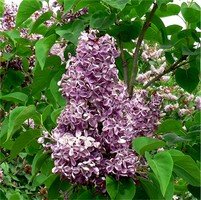
French Lilac Syringa vulgaris
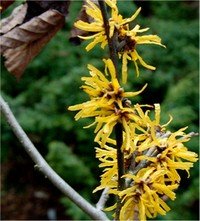 Witch Hazel Hamamelis intermedia
Witch Hazel Hamamelis intermedia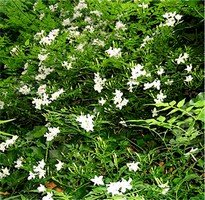
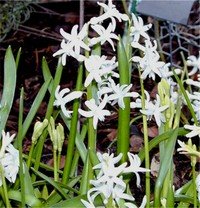
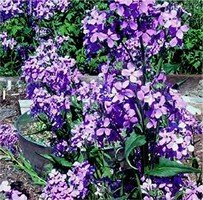
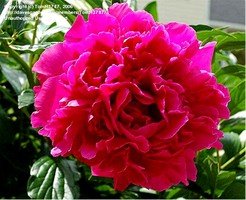
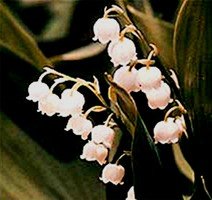
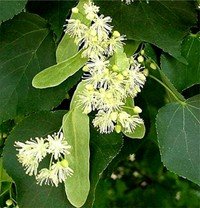
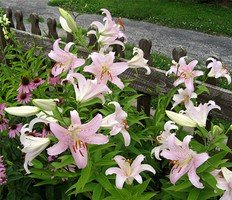
The end of May brings another favorite aroma, that of the linden blossom. While there is none in in our gardens, the fragrance from a tree just up the street drifts our way when the breezes blow from the southwest.
A succession of lilies provides fragrance throughout the summer months and into early fall. I've planted some especially long-blooming ones beside a bench where I sometimes rest from my garden labors or just sit to savor the garden that surrounds me.
The season ends with the pleasant vanilla fragrance of sweet autumn clematis. It climbs the trellised exterior of our screen house on all four sides(see photo below). We get to enjoy it every evening as we linger over a supper carried all the way out from the kitchen of the main house.
Even if you don't have much room in your yard for a garden, you can provide your own floral fragrance with ease. Why not plant, say, a lily or two near a doorway or some other sunny location in your yard that you pass by frequently? Fall is an ideal time to plant lilies, and modern varieties are easy to grow. They require very little care and come back year after year.
You say you have no yard? Ask your local garden center next spring for an appropriate pot, an appropriate lily variety, and some potting soil. Just plant at the recommended depth, set the pot in a sunny spot (even indoors on a windowsill will do for many lily varieties) and add water whenever the top of the soil starts to dry. Your brief efforts will reward you many times over in beauty and fragrance.
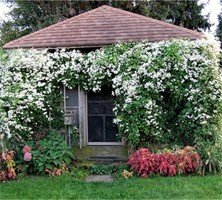
Other fragrant blooms to try
The following list contains only a sampling of plants from each category. Click on the links for detailed information on each plant.
Trees
Flowering plum Prunus blireiana
Magnolia spp.
Horse Chestnut Aesculus hippocastanum
Black locust Robinia pseudoacacia
Shrubs
Winter Daphne Daphne odorata
Tree Hydrangea 'Limelight'
Mock-orange Philadelphus spp.
Summer Sweet Clethra spp.
Vines
Wisteria spp.
Japanese honeysuckle Lonicera japonica
Evergreen Clematis Clematis armandii
Corkscrew Vine Vigna caracalla
Perennials
Pinks/Carnations Dianthus spp.
Hosta Hosta plantaginea
Agastache spp.
Bearded Iris spp.
Annuals
Laurentia Isotoma axillaris
Petunia WaveTM series
Sweet Alyssum Lobularia maritima
Devil's Trumpet Datura spp.
© Larry Rettig 2008
Thanks to DG members Dave, rebecca101, mgarr, bonatin, chrisw99, poppysue, TomH3787, Debsey, and Jeff_Beck for the use of their photos.
For additional references to fragrant plants, see also articles by fellow DG writers.
Fescue lawn getting thin and bare
WholeBlossoms Wholesale Roses and Wedding Flowers Online Sale
Minneapolis Severe Storms Tornadoes and Save your Home
Gardening Today: Types and Benefits of Garden Shredders
How to Grow Thyme for its Fragrance and Flavor
Garden Jokes and Humor: Daves Garden Sunday Funnies 08-09-15
Copyright © www.100flowers.win Botanic Garden All Rights Reserved